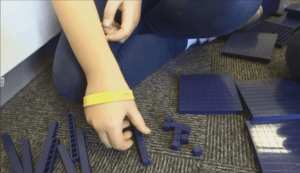Base ten block facts for kids
Base ten blocks are special tools that help students learn about numbers and math. They are also called multibase arithmetic blocks (MABs) or Dienes blocks, named after a smart Hungarian mathematician named Zoltán Pál Dienes. He was one of the first to talk about using these blocks to make learning math easier and more fun.
These blocks are super helpful for understanding big ideas like place value (what each digit in a number means) and how to do arithmetic (like adding, subtracting, multiplying, and dividing).
Contents
What Are Base Ten Blocks?
Base ten blocks are a hands-on way to see and touch numbers. They come in four main shapes, and each shape stands for a different value in our number system, which is based on groups of ten.
- Units: These are small, single cubes. They represent the number one. Think of them as individual items.
- Rods: These are long sticks made of ten units joined together. They represent the number ten.
- Flats: These are square blocks made of ten rods joined together, or one hundred units. They represent the number one hundred.
- Cubes: These are large cubes made of ten flats joined together, or one thousand units. They represent the number one thousand.
How Do You Use Base Ten Blocks?
You can use these blocks to build numbers and solve math problems. They help you understand how numbers are put together.
Showing Place Value
One of the main uses for base ten blocks is to show place value. Every digit in a number has a specific value based on its position.
- For example, to show the number 593:
- You would use 5 flats (which equal 500).
- Then, you would add 9 rods (which equal 90).
- Finally, you would place 3 units (which equal 3).
- Putting them all together, you can see how 500 + 90 + 3 makes 593. This helps you understand that the '5' in 593 means 500, not just 5.
Learning Addition
Adding numbers with base ten blocks is like combining groups of blocks.
- Let's say you want to add 123 + 245.
- First, show 123 using 1 flat, 2 rods, and 3 units.
- Next, show 245 using 2 flats, 4 rods, and 5 units.
- Now, combine all the units (3 + 5 = 8 units).
- Combine all the rods (2 + 4 = 6 rods).
- Combine all the flats (1 + 2 = 3 flats).
- Your total is 3 flats, 6 rods, and 8 units, which means 368.
Learning Subtraction
Subtracting with base ten blocks means taking blocks away. Sometimes, you need to "regroup" or "borrow" blocks.
- Imagine you want to subtract 25 from 42.
- Start with 4 rods and 2 units to represent 42.
- You need to take away 5 units, but you only have 2. So, you "trade" one rod for ten units. Now you have 3 rods and 12 units.
- Take away 5 units from your 12 units (12 - 5 = 7 units left).
- Take away 2 rods from your 3 rods (3 - 2 = 1 rod left).
- What's left is 1 rod and 7 units, which means the answer is 17.
Base ten blocks make abstract math ideas more concrete and easier to understand, especially for younger learners.


